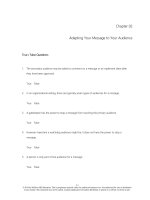Business communication building critical skill 3rd by locker module 8
Bạn đang xem bản rút gọn của tài liệu. Xem và tải ngay bản đầy đủ của tài liệu tại đây (405.29 KB, 10 trang )
PPT
PPT
Module
Module 88
Reader
Reader Benefits
Benefits
McGraw-Hill/Irwin
©2007, The McGraw-Hill Companies, All Rights
8-2
Reader
Reader Benefits
Benefits
To learn how to
Use audience analysis to identify
and choose reader benefits.
Develop reader benefits with logic
and details.
Match the benefit to the audience.
8-3
Reader
Reader Benefits
Benefits
Start by answering these questions:
Why do reader benefits work?
How do I identify reader benefits?
How detailed should each benefit
be?
How do I decide which benefits to
use?
What else do reader benefits need?
8-4
Reader
Reader Benefits
Benefits
Are advantages your reader gets
by
Using your services.
Buying your products.
Following your policies.
Adopting your ideas.
8-5
Good
Good Reader
Reader Benefits
Benefits Are
Are
Adapted to the audience.
Based on intrinsic advantages.
Supported by clear logic and
explained in adequate detail.
Phrased in you-attitude.
8-6
Maslow’s
Maslow’s Hierarchy
Hierarchy of
of Needs
Needs
Physical
Safety, Security
Love, Belonging
Esteem, Recognition
Self-Actualization (Highest)
8-7
Developing
Developing Reader
Reader Benefits
Benefits
In general,
Use 3-5 sentences of detail per
benefit.
If you develop 2-3 reader benefits
fully, use 1-2 sentences of detail for
less important benefits.
8-8
Developing
Developing Reader
Reader Benefits
Benefits
continued
continued
Use vivid, strong detail.
Psychological Description
Is creating a scenario rich with
sense impressions.
8-9
Developing
Developing Reader
Reader Benefits
Benefits
continued
continued
Brainstorm twice as many
benefits as needed
Use at least one benefit for each
part of your audience.
Use intrinsic benefits.
Use benefits you can develop most
fully.
Use you-attitude.
8-10
Psychological
Psychological Description
Description
Describe what the audience can
see, hear, smell, taste, and feel.
Example: Balancing precariously on a
rickety ladder to clean upper-story
windows . . . Shivering outside in the
winter winds and broiling in the summer
sun as you scrub away . . . Cleaning
with traditional windows really is
awful . . . In contrast, cleaning is a
breeze with Tilt-in Windows.









